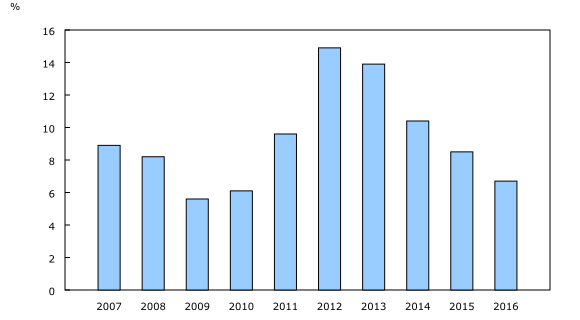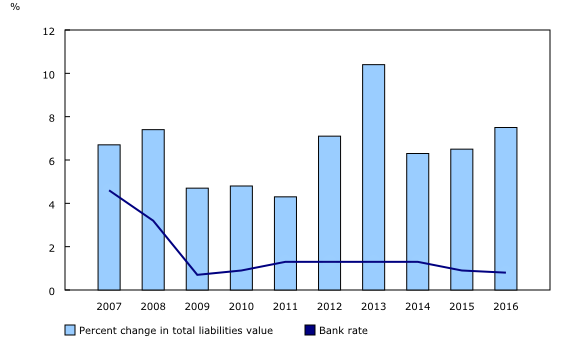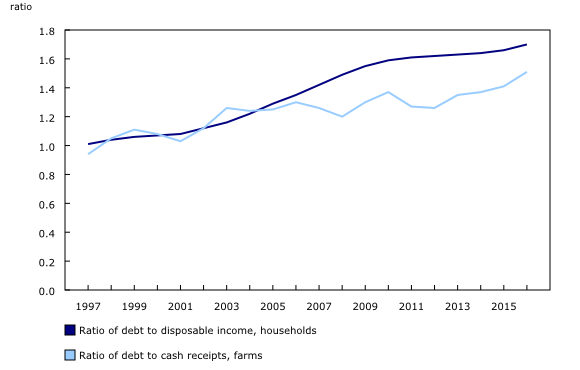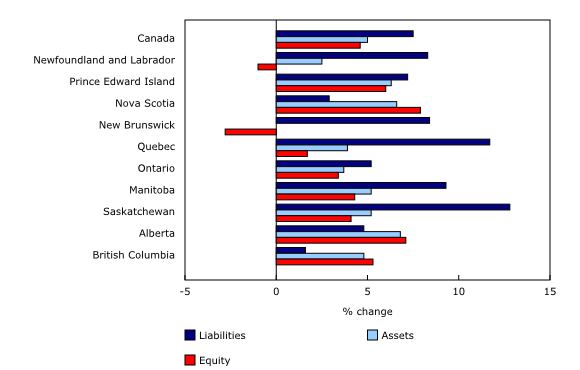Balance sheet of the agricultural sector, December 31, 2016 (revised data)
Archived Content
Information identified as archived is provided for reference, research or recordkeeping purposes. It is not subject to the Government of Canada Web Standards and has not been altered or updated since it was archived. Please "contact us" to request a format other than those available.
Released: 2018-01-18
$500.5 billion
December 31, 2016
4.6% 
(annual change)
$0.3 billion
December 31, 2016
-1.0% 
(annual change)
$2.0 billion
December 31, 2016
6.0% 
(annual change)
$2.6 billion
December 31, 2016
7.9% 
(annual change)
$2.1 billion
December 31, 2016
-2.8% 
(annual change)
$49.8 billion
December 31, 2016
1.7% 
(annual change)
$136.5 billion
December 31, 2016
3.4% 
(annual change)
$37.2 billion
December 31, 2016
4.3% 
(annual change)
$92.6 billion
December 31, 2016
4.1% 
(annual change)
$141.8 billion
December 31, 2016
7.1% 
(annual change)
$35.6 billion
December 31, 2016
5.3% 
(annual change)
Canadian farm equity increased to $500.5 billion at year-end 2016, up 4.6% from a year earlier as the increase in the value of assets outpaced that of liabilities. The total asset value on Canadian farms increased 5.0% from 2015, to $591.3 billion in 2016. The largest increase was in Alberta, up 6.8% to $162.4 billion in 2016.
Farm real estate values continued to drive farm asset values. While the 6.7% year-over-year increase in 2016 was the smallest since 2010, real estate's share of total asset value continued to climb. In 2016, more than three-quarters of farm asset value was in real estate, rising from two-thirds in 2007.
Most provinces showed percentage increases in real estate values lower than their 2012 and 2013 peaks, including the smallest percentage increases for Ontario and Saskatchewan in a decade.
Value of farm inventories decreases
The total value of Canadian farm inventories of crops, inputs, poultry and livestock (including breeding livestock), decreased 6.7% from 2015 to $45.1 billion.
The decreased value of farm inventories was driven by a 15.0% decline in livestock and poultry inventory value (including breeding livestock) from 2015 to 2016, due to lower prices following two years of strong price gains. The $3.7 billion decrease was driven by lower prices for beef cows (-17.2%) and for calves (-23.2%). All provinces recorded decreases in poultry and livestock inventory value.
Despite a slight decline in prices, crop inventory value increased 2.8% from 2015 to $18.4 billion in 2016. A gain in wheat and lentil stocks followed a 15.0% increase in wheat production and a 27.9% increase in lentil production in 2016. High stocks were driven by an increase of durum wheat production and global lentil oversupply in 2016.
Debt to receipts ratio continues to increase
Interest rates have remained relatively stable since 2009. The 2.7% prime business rate of 2016 was 0.3 percentage points higher than the historic low seen in 2009. In this climate of low borrowing costs and farms expanding and consolidating to remain competitive, total liability value has shown consistent year-over-year increases. In 2016, total liabilities increased 7.5% from 2015 to $90.8 billion.
Although farm cash receipts have been increasing, liabilities have risen at a higher rate. In 2016, farm operators and non-operator landlords reported $1.51 in debt for each $1 in gross farm receipts, increasing from $0.94 two decades earlier. This increase in debt-to-receipts is comparable to the change in the ratio in households. In 2016, households reported $1.70 of debt for each $1 of disposable income, up from $1.01 of debt in 1997.
However, the interest coverage ratio suggests Canadian farmers have earned sufficient revenues to meet interest payments. The interest coverage ratio assesses the ability to cover interest charges with the net income generated (before interest and taxes). The interest coverage ratio of 4.5 points in 2016 was greater than the 10-year average by 1.2 points.
Farm equity increases at a slower pace
Nova Scotia had the largest percentage increase in equity (+7.9%), while Alberta accounted for the largest value increase (+$9.4 billion), representing 42.6% of the total $22.0 billion increase from 2015.
The increase in farm equity of 4.6% was the smallest percentage rise in farm equity in Canada since 2009, with all provinces except Newfoundland and Labrador and New Brunswick reporting an increase. Manitoba and Saskatchewan recorded their smallest year-over-year percentage increases in a decade.
Note to readers
The balance sheet of the agricultural sector provides the value of farm assets used to produce agricultural products, the liabilities associated with these assets and the farm sector equity as of December 31 for Canada and the provinces.
Assets and liabilities in the agriculture sector's balance sheet include those of farm businesses and non-operator landlords (for farm real estate assets leased to farm operators and the corresponding liabilities) and exclude the personal portion of farm households. This most closely reflects the assets and liabilities used in the production of agricultural products.
The balance sheet of the agricultural sector integrates data already produced by Statistics Canada, such as farm debt, value of farm capital, livestock and crop estimates, farm product prices and selected data from the Farm Financial Survey. These data are subject to revision.
Contact information
For more information, or to enquire about the concepts, methods or data quality of this release, contact us (toll-free 1-800-263-1136; 514-283-8300; STATCAN.infostats-infostats.STATCAN@canada.ca) or Media Relations (613-951-4636; STATCAN.mediahotline-ligneinfomedias.STATCAN@canada.ca).
- Date modified:





